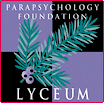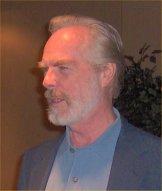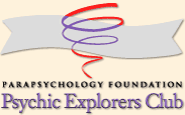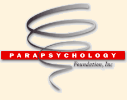 |
 |
| THE BIOGRAPHICAL DICTIONARY OF PARAPSYCHOLOGY ROGER NELSON This autobiography was written for the PF Lyceum Blog #11, “Lives in Parapsychology.” A more formal biography will be posted in the coming months. Roger Nelson  I was a curious kid, fascinated by unusual and exotic ideas. Growing up in North Platte, Nebraska, there were no gurus, but the local library was a good teaching resource. I had heard about Judo and Jujitsu and was immediately intrigued, but when I went looking for a book to learn the martial arts, I discovered instead one on Yoga. Its co-authors were Indian and German, and their combination of eastern and western perspectives produced a marvelous introduction to some new ideas; I forgot about Judo for the time being. In addition to their detailed instructions for hatha yoga, Yesudian and Haich included subtle lessons of broad and surprising wisdom. One memorable discussion modeled for me an exemplary situational intelligence, a respect for context: a vegetarian diet is ideal, but not for an Eskimo. I was a curious kid, fascinated by unusual and exotic ideas. Growing up in North Platte, Nebraska, there were no gurus, but the local library was a good teaching resource. I had heard about Judo and Jujitsu and was immediately intrigued, but when I went looking for a book to learn the martial arts, I discovered instead one on Yoga. Its co-authors were Indian and German, and their combination of eastern and western perspectives produced a marvelous introduction to some new ideas; I forgot about Judo for the time being. In addition to their detailed instructions for hatha yoga, Yesudian and Haich included subtle lessons of broad and surprising wisdom. One memorable discussion modeled for me an exemplary situational intelligence, a respect for context: a vegetarian diet is ideal, but not for an Eskimo.
The library offered more. My high school friends and I learned about hypnosis and tried it on each other, successfully demonstrating virtual anesthesia, among other phenomena. I was not highly hypnotizable, but I could have pins stuck in the back of my hand with no pain, just a dull pressure. One evening we hypnotized Gail and told him Roger was gone. I played catch with Jim, tossing a ball of crumpled paper back and forth. Gail was genuinely amazed and a little frightened to see the ball caught and returned by nobody; by magic in thin air. North Platte was a small town far from intellectual centers, but its Carnegie library collection included a copy of Extrasensory Perception after 60 Years by Pratt, Rhine, Smith, et al. Obviously, as budding young scientists, we had to try these experiments. Our procedures followed those detailed by Rhine, though we had little conception of the real requirements of careful research, especially the scope implied by small and subtle effects. Nevertheless, I think our experiments were credible efforts — we were interested in what happens, and we weren’t distracted by trying to prove that some remarkable capacity exists. We were motivated by intellectual curiosity and were smart enough to know our questions could only be answered by doing it right. The answers we got were perfect in this sense. We saw successful card guessing at just the level that suggests an unexplained access to information exactly as Rhine described it. Nothing like stage magic; just a subtle excess of correct intuitions or hits in nicely designed, small experiments. For some years, through college, the military, graduate school, I didn’t think much about psi or consciousness research, though I gravitated toward experimental psychology and cognitive science. My first teaching job was at Johnson State College in northern Vermont, where I was a young professor with a wonderfully broad mandate in a small department. I taught introductory materials of course, but also created new courses in Alternative Psychologies, Applied Psychology, Philosophy and Psychology. I had opportunities to teach photography seminars and to produce and direct multimedia extravaganzas. This was, in a word, a creative environment, which nurtured my esoteric interests, and brought me together with bright, curious, and adventurous students, including some from whom I learned a great deal. And what topics did my students take up in their practical experimental or applied psychology labs? How about telepathy? How about hypnosis, dream studies, psychokinesis? Would meditation do as a topic? There were other things too, but my recollection is that something like half, maybe more, of my students wanted to explore the subtle aspects of human consciousness that are given short shrift in mainstream scientific psychology. In any case, though the textbooks then (and now, I suspect) had little to say about parapsychology, we found resources, worked hard, and had fun trying to learn something. The economic vicissitudes of the mid-1970’s pushed the administrators of Vermont’s state college system to redesign, shifting away from the liberal arts mission I valued toward career education via specialization. So I was motivated to seek a new venue. When a friend gave me a Chronicle of Higher Education with a couple of jobs circled, I noticed next to one of them an ad for a “cognitive psychologist with interests in the lesser known aspects of perception.” It was in the School of Engineering and Applied Science at Princeton University, and this enigmatic description was intriguing, so I wrote to them, with the salutation, “Dear Sir or Madam.” Apparently, of 40 or so applicants, I was the only one who displayed in this way a lack of preconceptions, and the Associate Dean handling the letters sent mine on to Bob Jahn and Brenda Dunne with a positive note. Within a few months, I was in Princeton, with a sabbatical year to test the waters of serious psi research in what came to be called the Princeton Engineering Anomalies Research (PEAR) laboratory. My wife, Lefty, and our dog, Nelson, both loved Vermont, but they were willing to try the waters, and Greg, who was 10 years old, immediately found real comrades when he started the 6th grade at John Witherspoon middle school. The year (it was 1980) went by without resolving any of our research questions, but I liked what we were doing and set up another year of leave, imagining that would be enough to solve the puzzles. After a few more months, I admitted to myself that this was a life’s work, and I decided to resign from my tenured faculty position at Johnson to let them get on with building the department — I wasn’t coming back. We had two experimental tracks at PEAR, in addition to theoretical concerns. One examined remote perception, and the other looked at interactions of consciousness with physical systems. My focus was most often on coordination of experimental design and analytical strategy, but I loved the challenges of developing and setting up equipment for experiments. We had the ability and resources to ensure scientific rigor, but we also gave serious attention to aesthetic aspects, and the result was a series of interesting and often beautiful devices and settings. Our first and most prolific experiment asked people to change the behavior of an electronic random event generator (REG), but we developed a series of variations to study what factors matter in mind-machine interactions. We built a giant “pinball/pachinko” machine, a crystal pendulum in a clear acrylic case, a fountain modeling chaotic systems, a native-American drum with a random beat, and a randomly driven robot carrying a charming “primordial” frog. Other experiments capitalized on our engineering environment, in which it was natural to exploit some exotic and extremely sensitive instruments. One of these was a Fabry-Perot interferometer, which produced a beautiful display of concentric circles of yellow light that we willed to expand or contract. (It was capable of detecting waves crashing on the New Jersey shore, and was arguably an especially apt target for subtle effects of consciousness.) The remote perception experiments asked whether a percipient could envision a scene visited by an agent, without any normal means of communication. We developed protocols that allowed us to quantify anomalous information transfer. Ultimately we were able to show that extrasensory access to unknown target sites was not only possible, but could occur over distances ranging up to thousands of miles, and more surprisingly, over time displacements of hours or days. We collected a large and consistent database that confirmed and extended the work of other research teams in remote viewing, Over the years, our focus changed gradually from experiments to establish the viability of the research and the validity of concepts, to studies asking incisive questions about the important factors in psi effects. This naturally also produced new dimensions and protocols. In the early 90’s my particular focus shifted to the idea of “fields” of consciousness. In the lab, people attempted to influence an REG‘s behavior by intention, that is, by wishing for changes in the output. The positive results implied questions about more general effects of consciousness, both in the laboratory and in the real world. Miniaturized electronics allowed us take an REG with a laptop or palmtop computer into the field for studies of group consciousness. We hypothesized that special states of consciousness might affect REG behavior, even without intentions. And indeed we found that data from numinous situations often show excess variability, suggesting that coherence or resonance among groups of people somehow adds information to otherwise random systems. The next phase of my personal journey followed the logic of group consciousness to global dimensions. In 1997 I started work on the Global Consciousness Project (GCP), a world-spanning network of REGs producing continuous data that we hypothesized might show effects correlated with major events in the world. After some creative discussions with colleagues, I organized a remarkable group of volunteers who in short order built an infrastructure supporting what we sometimes call the EGG Project, an acronym for “ElectroGaiaGram.” Altogether, more than 100 people are involved, some as analysts and programmers, many as hosts for approximately 65 “Eggs,” each consisting of an REG and special computer software. Data collection began in 1998, and we now have more than seven years of continuous parallel sequences of random numbers which we examine for evidence of non-random structure. In 2002, I retired from the PEAR lab to give full attention to the GCP. It is an interesting project in many ways, not least because it touches so many people all over the world. As for the results of this long-term project, they have the character of most psi research in showing small statistical effects with very large implications. The data do show departures from expectation when major events draw much of humankind into a similar state of mind and emotion. Especially when our compassion is evoked, the data change; they are no longer random. A quarter century after I started my career in consciousness research thinking a year or two should answer the major questions, and after a full century of historical parapsychology, we still can’t say how psi works. But the databases and analytical results are full of suggestive indicators. I think these ultimately will help shape better questions, and these will progressively reveal more of the subtle character of human consciousness. Both the laboratory and the field experiments yield statistically significant results. They show that although the touch of consciousness in the world is subtle, it is real. The effects are so small it is difficult to prove that they matter or have any practical applications. But for me it is clear that direct interactions of consciousness and the physical world have far-reaching philosophical and scientific importance. What we envision or pray for is just a little more likely to happen, because consciousness is literally creative. Ultimately, this work supports an understanding that we humans have the capability and responsibility for conscious evolution. Our future is in our minds. Nelson, R. D. (in press). Time-Normalized Yield: A Natural Unit for Effect Size in Anomalies Experiments. Journal of Scientific Exploration. Nelson, R. D., Radin, D. I. Shoup, R. Bancel, P. A. (2002). Correlations of Continuous Random Data with Major World Events. Foundations of Physics Letters, 15,(6), 537–550. Nelson, R. D. (2002). Coherent Consciousness and Reduced Randomness: Correlations on September 11, 2001. Journal of Scientific Exploration, 16,(4), 549–570. Nelson, R. D. (2001). Correlation of Global Events with REG Data: An Internet-Based, Nonlocal Anomalies Experiment. The Journal of Parapsychology, 65, 247–271. R.D. Nelson, R.G. Jahn, Y.H. Dobyns, and B.J. (2000). Contributions to Variance in REG Experiments: ANOVA Models and Specialized Subsidiary Analyses. Journal of Scientific Exploration, 14,(1), 73–89. Nelson, R. D. (1999). The Physical Basis of Intentional Healing Systems. Technical Report PEAR 99001. Princeton University: Princeton Engineering Anomalies Research. Nelson, R. D. (1997). Wishing for Good Weather: A Natural Experiment in Group Consciousness. Journal of Scientific Exploration, 11,(1), 47–58. Nelson, R. D., Bradish, G. J., Dobyns, Y. H., Dunne, B. J., Jahn, R. G. (1998). FieldREG II: Consciousness Field Effects: Replications and Explorations. Journal of Scientific Exploration, 12,(3), 425–454. Nelson, R. D., Bradish, G. J., Dobyns, Y. D., Dunne, B. J., Jahn, R. G. (1996). FieldREG Anomalies in Group Situations, Journal of Scientific Exploration, 10,(1), 111. Nelson, R. D., Bradish, G. J., Jahn, R. G., and Dunne, B. J. (1994). A linear pendulum experiment: Operator effects on damping rate. Journal of Scientific Exploration, 8,(4), 471–489. (Also available as Technical Note PEAR 93003). Nelson, R. D., Ziemelis, U. O., and Cook, I. A. (1992). A Microelectronic Chip experiment: Effects of operator intention on error rates. Technical Note PEAR 92003. Princeton University: Princeton Engineering Anomalies Research. Nelson, R. D., Dunne, B. J., and Jahn, R. G. (1982). Psychokinesis studies with a Fabry-Perot interferometer. Research in Parapsychology, 1981. Metuchen, NJ: Scarecrow Press. ********* |
 |

|
 www. parapsychology. org |
||